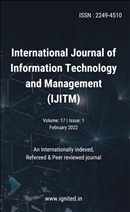MEETVERSE: A new way of Interaction on Online Meeting Platforms
Main Article Content
Authors
Abstract
Online meeting platforms are used widely in today’s era of Digital India. These meetingplatforms are used in providing online education, online dating and online business meetings, etc. Duringthe last decade, there is quite a development in online meeting methods. At present the meetingapplications solve almost everything be it sharing screen, muting mic, disabling your camera, andchanging the background but still they sometimes become boring. This article presents ways to makemeeting applications more interesting using Avatar formation, interacting using Avatar, and providing handgesture controls to increase and decrease the volume of the meeting platform.Different deep learning techniques are required to make different avatars according to different people.Different Machine learning and Computer Vision techniques are used such as face recognition forextracting the features from the face to directly apply them to the Avatar. These methods and features arean add-on to the existing Meeting Applications, which makes them more interactive.
Downloads
Download data is not yet available.
Article Details
Section
Articles
References
- StyalianosMystakidis, Metverse, School of Natural Sciences, University of Patras, 28, December 2021
- Rajendran, Ganesh B., Uma M. Kumarasamy, Chiara Zarro, Parameshachari B. Divakarachari, and Silvia L. Ullo. "Land-use and land-cover classification using a human group-based particle swarm optimization algorithm with an LSTM Classifier on hybrid pre-processing remote-sensing images."Remote Sensing12, no. 24 (2020): 4135
- AjitkumarShitole and ManojDevare, “Optimization of Person Prediction Using Sensor Data Analysis of IoT Enabled Physical Location Monitoring”, “Journal of Advanced Research in Dynamical and Control Systems”, Dec 2018, Volume: 10, Issue: 9, pp. 2800-2812, ISSN: 1943-023X.
- Steve Roberts, Character Animation Fundamentals, 11 August 2021
- Chakraborty, C., Roy,S., Sharma, S., Tran, T., Dwivedi, P. and Singha, M., 2021. IoT Based Wearable Healthcare System: Post COVID-19. The Impact of the COVID-19 Pandemic on Green Societiesenvironmental Sustainability, pp.305-321.
- Seyhan, K., Nguyen, T.N., Akleylek, S., Cengiz, K. and Islam, S.H., 2021. Bi-GISIS KE: Modified key exchange protocol with reusable keys for IoT security. Journal of Information Security and Applications, 58, p.102788.
- W. Youyou, M. Kosinski, and D. Stillwell, “Computer-based personality judgments are more accurate than those made by humans,” Proc. Natl.Acad. Sci., vol. 112, no. 4, pp. 1036–1040, Jan. 2015.135
- H. A. Schwartz et al., “Predicting individual well-being through theLanguage of social media,” Pac. Symp. Biocomput., vol. 21,pp. 516–527, 2016.
- J. H. Kietzmann, K. Hermkens, I. P. McCarthy, and B. S. Silvestre,“Social media? Get serious! Understanding the functional building blocks of social media,” Bus. Horiz., vol. 54, no. 3, pp. 241–251, May 2011.
- Chakraborty, C., Roy, S., Sharma, S., Tran, T., Adhimoorthy, P., Rajagopalan, K. andJebaranjitham, N., 2021. Impact of Biomedical Waste Management System on Infection Control in the Midst of COVID-19 Pandemic. The Impact of the COVID-19 Pandemic on Green Societiesenvironmental Sustainability, pp.235-262.
- C. Perlich, B. Dalessandro, T. Raeder, O. Stitelman, and F. Provost,“Machine learning for targeted display advertising: transfer learning inaction,” Mach. Learn., vol. 95, no. 1, pp. 103–127, Apr. 2014.
- L. Zhen, A. K. Bashir, K. Yu, Y. D. Al-Otaibi, C. H. Foh, and P. Xiao, “Energy-Efficient Random Access for LEO Satellite-Assisted 6G Internet of Remote Things”, IEEE Internet of Things Journal ,doi:10.1109/JIOT.2020.3030856.
- L. Zhen, Y. Zhang, K. Yu, N. Kumar, A. Barnawi and Y. Xie, "Early Collision Detection for Massive Random Access in Satellite-Based Internet of Things," IEEE Transactions on Vehicular Technology, vol. 70, no. 5, pp. 5184-5189, May 2021, doi: 10.1109/TVT.2021.3076015.
- L. Tan, K. Yu, A. K. Bashir, X. Cheng, F. Ming, L. Zhao, X. Zhou, “Towards Real-time and Efficient Cardiovascular Monitoring for COVID-19 Patients by 5G-Enabled Wearable Medical Devices: A Deep Learning Approach”, Neural Computing and Applications, 2021, https://doi.org/10.1007/s00521-021-06219-9.
- Subramani, Prabu, K. Srinivas, R. Sujatha, and B. D. Parameshachari. "Prediction of muscular paralysis disease based on hybrid feature extraction with machine learning technique for COVID-19 and post-COVID-19 patients."Personal and Ubiquitous Computing(2021): 1-14.
- Nguyen, Ngoc‐Tu, Ming C. Leu, and Xiaoqing Frank Liu. "RTEthernet: Real‐time communication for manufacturing cyberphysicalsystems."Transactions on Emerging Telecommunications Technologies29, no. 7 (2018): e3433.
- Rajendrakumar, Shiny, V. K. Parvati, B. D. Parameshachari, KMSunjivSoyjaudah, and ReshmaBanu. "An intelligent report generator for efficient farming." In2017 International Conference on Electrical, Electronics, Communication, Computer, and Optimization Techniques (ICEECCOT), pp. 1-5. IEEE, 2017.
- A Systematic Review of Emoji: Current Research and Future Perspectives, Published online 2019 Oct15. doi: 10.3389/fpsyg.2019.02221, PMCID: PMC6803511, PMID: 31681068 , Qiyu Bai,1,2,* Qi Dan,1,† Zhe Mu,1,† and Maokun Yang1,†
- Fang Han, Xuesong Bo, “Research and Literature on Developing Motion Capture System for Analyzing Athelets Action”
- Zoom Meeting Research Paper.docx - Alexandra Daino Zoom...
- Body and mind: A study of avatar personalization in three virtual worlds, April 2009, DOI:10.1145/1518701.1518877, Source,DBLP
- All One Needs to Know about Metaverse: A Complete Survey on Technological Singularity, Virtual Ecosystem, and Research Agenda, October 2021, DOI:10.13140/RG.2.2.11200.05124/8, Project: The Planet-

